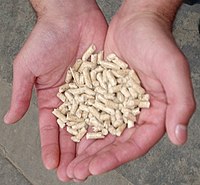
Saproxylic species are linked to the amount and isolation of dead wood across spatial scales in a beech forest
Sign Up to like & getrecommendations! Published in 2020 at "Landscape Ecology"
DOI: 10.1007/s10980-020-01115-4
Abstract: Context Dead wood is a key habitat for saproxylic species, which are often used as indicators of habitat quality in forests. Understanding how the amount and spatial distribution of dead wood in the landscape affects saproxylic… read more here.
Keywords: spatial scales; amount isolation; dead wood; wood ... See more keywords

Experiments with dead wood reveal the importance of dead branches in the canopy for saproxylic beetle conservation
Sign Up to like & getrecommendations! Published in 2018 at "Forest Ecology and Management"
DOI: 10.1016/j.foreco.2017.11.052
Abstract: Abstract Vertical gradients of habitats are a typical characteristic of forest ecosystems. Sun-exposed dead wood in the upper canopy, for instance, provides a habitat for saproxylic beetles distinct from that in the more shaded dead… read more here.
Keywords: upper canopy; saproxylic beetle; dead wood; near ground ... See more keywords

Is shelterwood harvesting preferable over clear-cutting for sustaining dead-wood pools? The case of Estonian conifer forests
Sign Up to like & getrecommendations! Published in 2018 at "Forest Ecology and Management"
DOI: 10.1016/j.foreco.2018.07.026
Abstract: Abstract Shelterwood is commonly assumed to be a more nature-friendly silvicultural system than clear-cutting. However, dead-wood pools – a key characteristic of natural forest – have been seldom compared between these systems. We investigated how… read more here.
Keywords: clear cutting; dead wood; wood pools; shelterwood harvesting ... See more keywords

Saproxylic beetle assemblages in recently dead Scots pines: How traits modulate species’ response to forest management?
Sign Up to like & getrecommendations! Published in 2020 at "Forest Ecology and Management"
DOI: 10.1016/j.foreco.2020.118300
Abstract: Abstract Boreal forests have been intensively managed, influencing the spatiotemporal occurrence of dead wood, and leading to changes in saproxylic species assemblages. Some particular traits, such as habitat specialization, can be expected to make species… read more here.
Keywords: beetle assemblages; saproxylic beetle; scots pines; dead wood ... See more keywords

Fire, drought and productivity as drivers of dead wood biomass in eucalypt forests of south-eastern Australia
Sign Up to like & getrecommendations! Published in 2021 at "Forest Ecology and Management"
DOI: 10.1016/j.foreco.2020.118859
Abstract: Abstract Dead wood, including dead standing trees (DST) and coarse woody debris (CWD), is a critical component of forest ecosystems that provides habitat and refugia for fauna, flora, and microbial communities and plays a key… read more here.
Keywords: wood biomass; dead wood; eastern australia; south eastern ... See more keywords

Simulated long-term effects of varying tree retention on wood production, dead wood and carbon stock changes.
Sign Up to like & getrecommendations! Published in 2017 at "Journal of environmental management"
DOI: 10.1016/j.jenvman.2017.06.026
Abstract: Boreal forests are an important source of timber and pulp wood, but provide also other products and services. Utilizing a simulation program and field data from a tree retention experiment in a Scots pine forest… read more here.
Keywords: carbon stock; tree retention; dead wood; retention ... See more keywords

Urban forests host rich polypore assemblages in a Nordic metropolitan area
Sign Up to like & getrecommendations! Published in 2021 at "Landscape and Urban Planning"
DOI: 10.1016/j.landurbplan.2021.104222
Abstract: Abstract Urban forests are often remnants of former larger forested areas, and traditionally considered as degraded habitats due to negative effects of urbanization. However, recent studies have shown that urban forests managed for recreational purposes… read more here.
Keywords: polypore assemblages; polypore; urban forests; dead wood ... See more keywords

Carbon fractions in the world’s dead wood
Sign Up to like & getrecommendations! Published in 2021 at "Nature Communications"
DOI: 10.1038/s41467-021-21149-9
Abstract: A key uncertainty in quantifying dead wood carbon (C) stocks—which comprise ~8% of total forest C pools globally—is a lack of accurate dead wood C fractions (CFs) that are employed to convert dead woody biomass… read more here.
Keywords: wood; wood carbon; dead wood; carbon fractions ... See more keywords

Biological traits explain bryophyte species distributions and responses to forest fragmentation and climatic variation
Sign Up to like & getrecommendations! Published in 2018 at "Journal of Ecology"
DOI: 10.1111/1365-2745.12930
Abstract: Forest ecosystems have been subjected to intensive exploitation, and on top of these land use-driven habitat alterations, there is an ongoing and rapid climate change. Understanding why environmental responses differ across species and how differences… read more here.
Keywords: variation; bryophyte species; inhabiting bryophytes; dead wood ... See more keywords

Nutritional dynamics during the development of xylophagous beetles related to changes in the stoichiometry of 11 elements
Sign Up to like & getrecommendations! Published in 2017 at "Physiological Entomology"
DOI: 10.1111/phen.12168
Abstract: The present study examines the adaptive strategy used by wood‐boring beetles to compensate for the lack of nutrients in dead wood. The contents of nutritional elements in growing wood‐boring beetles (Stictoleptura rubra L. and Chalcophora… read more here.
Keywords: wood; nutritional dynamics; dead wood; larval development ... See more keywords

Effects of retained dead wood on predation pressure on herbivores in young pine forests
Sign Up to like & getrecommendations! Published in 2022 at "PLoS ONE"
DOI: 10.1371/journal.pone.0273741
Abstract: Retention of logging residue as dead wood could be a method to simultaneously increase biodiversity and predation rates of pest insects, in managed forests. Managed forests are generally low in diversity, and dead wood has… read more here.
Keywords: effect; predation rates; dead wood; diversity ... See more keywords